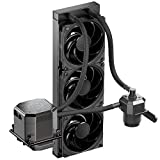
The Peltier Effect happens when electric current is passed through a bimetal junction, cooling one side and heating the other. While Peltier coolers have been used in computers, their numerous drawbacks have kept them out of the mainstream.
You can cool a CPU or GPU with water, air, and liquid nitrogen, but what about electrons? Peltier coolers can use the magic of electricity and physics to chill your components, but there’s a reason we don’t all use them.
What Is The Peltier Effect?
The Peltier effect (also known as the thermoelectric cooling effect) is when electricity is used to cool or heat a material. It is named after French physicist Jean Charles Athanase Peltier, who discovered it in 1834. The Peltier effect is the phenomenon that occurs when an electric current flows through a junction between two different types of materials, causing a temperature difference to appear at the junction. This temperature difference can be used to cool or heat the junction, depending on the direction of the current. This effect can be used in devices such as thermoelectric coolers (TEC), which are used to cool electronic devices, and in heating pads or other heating devices.

The Peltier effect is also referred to as “solid-state refrigeration” because it uses solid-state materials (such as semiconductors) to achieve cooling, rather than traditional methods like compression and evaporation of refrigerants. This makes it a more efficient and eco-friendly alternative to traditional refrigeration methods. The Peltier effect is also used in the reverse direction, where it can be used to generate heat instead of cooling. This is often used in heating pads, hand warmers, and other similar devices.
Incidentally, the inverse is also true. If you subject the two sides of the junction to a temperature difference, you’ll generate electricity instead. This is known as the Seebeck Effect.
How Peltier Coolers Work
When you use a Peltier cooler in your computer, it attaches to your CPU and uses electricity to cool the CPU. On one side of the cooler, heat is absorbed from the CPU, and on the other side, it is released. A fan is also used to help dissipate the heat released from the cooler’s hot side.
To put it simply, Peltier coolers use electricity to move heat from the hot side to the cold side, and the fan helps to cool the hot side, which in turn cools the CPU. So the “peltier” part of the cooler is actually a heat pump, rather than a cooling system by itself. You still need traditional air or water cooling to get rid of the heat.
Are Peltier Coolers Better? Pros and Cons
Peltier coolers can provide very high cooling performance, especially when compared to traditional air coolers. They can effectively lower the temperature of a CPU, even under heavy loads. That includes cooling processors to below the ambient temperature.
Peltier coolers are also generally smaller in size compared to air coolers, which makes them ideal for use in small form-factor PCs or tight spaces. They can be used to move heat out of those tight spaces to where it can be dissipated easily.
On the negative side of things, Peltier coolers consume a lot of power, which can result in higher electricity bills and put a strain on your computer’s power supply. They’re also generally more expensive than traditional air coolers and often don’t have better cooling in absolute terms compared to air or water cooling.
Because they can cool processors to below ambient temperatures, Peltier coolers can cause condensation, which can damage the internal parts of the computer by causing electrical shorts and corrosion.
Real-World Peltier CPU Coolers
Finding CPU coolers that use the Peltier effect, often labeled as “TEC” coolers, proves somewhat tricky. There were several of them in the late 2000s and early 2010s, but since then, they’ve been rather scarce.
There are still products you can buy under the Intel Cryo brand, implemented by third-party partners such as Cooler Master, who have cleverly combined Peltier cooling technology with AIO (All-In-One) water-cooling.
Cooler Master MasterLiquid ML360 SUB-Zero
Combining the power of water cooling with solid state refrigeration, the ML360 promises a literally chill experience when overclocking or simply maxing the boost clocks of your CPU.
It’s easier to find TEC coolers that aren’t specifically meant to cool PC CPUs, but rather designed for general semiconductor chip cooling. These are usually meant for DIY projects or special nonstandard computing systems that have to operate in conditions where TEC coolers make sense.
Why Aren’t Peltier PC Coolers Common?
You’d think that the ability of Peltier coolers to (potentially) achieve sub-ambient cooling would draw many overclocking enthusiasts to them, but so far they haven’t proven popular. The drawbacks of the technology we’ve already mentioned above certainly go some way as to why they haven’t taken off, but there’s more to it than that.
First of all, achieving sub-ambient temperatures isn’t really a goal anyone’s looking to achieve. A CPU running under its maximum safe temperature will work just as well right below that limit as it will right above its lower limit. As long as the CPU isn’t throttling and achieves its highest performance level without exceeding the safe temperature limit, you’re good to go.
Modern high-performance CPUs can put out hundreds of watts in thermal energy, and Peltier coolers require electricity to work. There’s a significant issue with diminishing returns when you have to use the Peltier effect to cool such high temperatures, and other cooling methods requiring much less power can get close enough to make Peltier coolers a niche within a niche.
So it’s not that surprising that these coolers aren’t mainstream. Right now there’s no real need for them, but future changes in how computers are designed, or the ongoing shift to mobile devices like gaming laptops (now with water cooling!) could change that.

